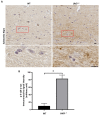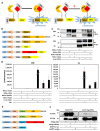UBL3 Interacts with Alpha-Synuclein in Cells and the Interaction Is Downregulated by the EGFR Pathway Inhibitor Osimertinib
- PMID: 37371780
- PMCID: PMC10295865
- DOI: 10.3390/biomedicines11061685
UBL3 Interacts with Alpha-Synuclein in Cells and the Interaction Is Downregulated by the EGFR Pathway Inhibitor Osimertinib
Abstract
Ubiquitin-like 3 (UBL3) acts as a post-translational modification (PTM) factor and regulates protein sorting into small extracellular vesicles (sEVs). sEVs have been reported as vectors for the pathology propagation of neurodegenerative diseases, such as α-synucleinopathies. Alpha-synuclein (α-syn) has been widely studied for its involvement in α-synucleinopathies. However, it is still unknown whether UBL3 interacts with α-syn, and is influenced by drugs or compounds. In this study, we investigated the interaction between UBL3 and α-syn, and any ensuing possible functional and pathological implications. We found that UBL3 can interact with α-syn by the Gaussia princeps based split luciferase complementation assay in cells and immunoprecipitation, while cysteine residues at its C-terminal, which are considered important as PTM factors for UBL3, were not essential for the interaction. The interaction was upregulated by 1-methyl-4-phenylpyridinium exposure. In drug screen results, the interaction was significantly downregulated by the treatment of osimertinib. These results suggest that UBL3 interacts with α-syn in cells and is significantly downregulated by epidermal growth factor receptor (EGFR) pathway inhibitor osimertinib. Therefore, the UBL3 pathway may be a new therapeutic target for α-synucleinopathies in the future.
Keywords: EGFR pathway inhibitor; UBL3; downregulate; drug screen; interaction; osimertinib; α-synuclein; α-synucleinopathies.
Conflict of interest statement
The authors declare no conflict of interest.
Figures





References
-
- Liu H., Wilson K.R., Firth A.M., Macri C., Schriek P., Blum A.B., Villar J., Wormald S., Shambrook M., Xu B., et al. Ubiquitin-like protein 3 (UBL3) is required for MARCH ubiquitination of major histocompatibility complex class II and CD86. Nat. Commun. 2022;13:1934. doi: 10.1038/s41467-022-29524-w. - DOI - PMC - PubMed
Grants and funding
LinkOut - more resources
Full Text Sources
Research Materials
Miscellaneous

